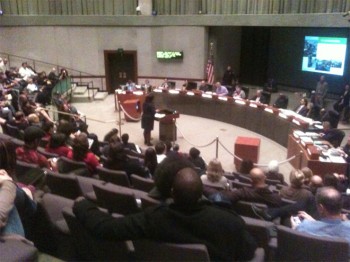
Last night’s city council meeting, Photo by Brian Ulaszewski
4:25pm | After an appeals hearing, extended public commentary, and exhaustive discussion and debate, the City of Long Beach is moving forward with the Downtown Community Plan.
By far the main point of contention concerned whether the Plan as a whole is too negatively impactful on low-income residents — as position voiced by Councilmembers Rae Gabelich and Steven Neal, along with Gerrie Schipske — by displacing them from their current homes (estimates ranged from 9,000 residents to 36,000 or more) and providing too little low-income housing in the downtown area.
“Where would these low-income residents go?” asked Neal.
Councilmember Suja Lowenthal took exception to some of the evening’s talk regarding the Plan’s potential impact on low-income residents, calling “the suggestion of [the Plan’s] displacing residents from our city […] fear-mongering. […] To suggest that this plan invites that is specious, at best. And I’m troubled by that.”
Neal, however, noted that the Plan’s own Environmental Impact Report (EIR) discusses this impact. Director of Development Services Amy Bodek admitted there is a possibility for displacement of some low-income residents, and agreed that the Plan contains no mitigation for that possibility.
As discussion progressed it became clear that Gabelich and Neal would be unable to make implementation of the Plan contingent upon its including greater concession to the low-income community. And in the end there was inadequate support even for Schipske’s attempt to get a report on emending the Plan to zone 10 percent of its residences as low-income housing, with the majority of the council and Mayor Bob Foster indicting their belief that the economic climate was not right for such measures.
Finally, Councilmembers Robert Garcia and Suja Lowenthal spearheaded moving the Plan forward as-is, along with instructions to city staff to provide reports on including provisions for project labor agreements, local hiring requirements, and right of first refusal for any residents displaced by new developments. And at 11:15 p.m., it was done.
During the process Gabelich expressed her concern regarding several aspects of the Plan, including its having grown in size from roughly 625 acres to 725 acres. She also poked fun at a suggestion in the EIR that a possible mitigation of a potential negative impact of razing a historical structure is to photograph it before doing so.
Schipske also expressed a number of other concerns, such as the inclusion of high-rise structures, noting that it is her understanding that the Long Beach Fire Department has limitations on the number of storeys its equipment can service. Planning Officer Derek Burnham did not directly address that issue, instead discussing requirements for meeting certain codes (e.g., helipads to meet upper-floor exiting requirements).
Another issue raised by Schipske was that the Plan insufficiently considers the downtown parking reality. “I get concerned when we increase density in an area that’s already parking impacted,” she said. “I’m concerned there’s not a mitigation here. […]”I’m concerned that we’re compounding the problem””
Bodek “suggest[ed] there is adequate parking downtown,” and that the Plan reflects this.
9:30am | The City Council on a 7-2 vote adopted the Downtown Plan, a master zoning and development document that encourages increased density, sustainability, historic preservation, and building heights in the Downtown. Councilmembers Steven Neal and Rae Gabelich voted against the plan, voicing concerns that the proposal would displace low income residents.
The Downtown Plan, which covers all of Downtown roughly between Ocean and Anaheim to Alamitos, has been in development for four years and streamlines development requirements by creating a master environmental impact report for the entire zone affected.
Housing Long Beach and the Legal Aid Foundation of Los Angeles argued that the plan needed to include community benefits in order to balance development incentives. Speaking in favor of the plan was a coalition of all six of the Downtown Neighborhood Association, the Downtown Long Beach Associates and the Long Beach Chamber of Commerce.
After 5 hours of debate and testimony, the Council supported the decision of the Planning Commission to move the Downtown Plan forward. In addition, the Council voted 7-2 to support a motion by Councilman Robert Garcia and seconded by Vice-Mayor Suja Lowenthal to begin a city-wide policy study on two of the proposed community benefits made by Housing Long Beach. They included a first-right of refusal policy for displaced low income residents, and a local hire policy that could include project labor agreements.

